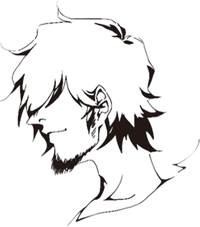Top>HAKUMON Chuo [2014 Spring Issue]>[Report of the Aftermath of the Great East Japan Earthquake] Assisting the residents of a devastated island
 Index
Index
Report of the Aftermath of the Great East Japan Earthquake
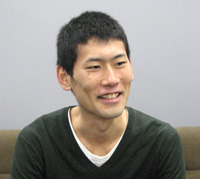
Assisting the residents of a devastated island
Student Volunteer Record
Motoki Yasuhara
4th year, Faculty of Policy Studies, awarded Student of the Year
Motoki Yasuhara, a 4th year student in the Faculty of Policy Studies from Miyagi Prefecture, was recognized by a prestigious group in the social contribution section as Student of the Year at Chuo University. Although he himself is a victim of the Great East Japan Earthquake, he contributed to the restoration of Oshima, an island off Kesennuma city.
On December 7, 2013, the Japan Student Services Organization (JASSO) commended Motoki Yasuhara of Chuo University, who received the 2013 Student of the Year award in the social contribution section. He was the first award winner in this section from Chuo University.
JASSO is a time-honored organization that took over the Japan Scholarship Foundation. Every year, it recognizes students who produce excellent achievements and outcomes in the fields of academics and sports. Besides Yasuhara, the other award-winning student out of the two from Chuo University was athlete Shinri Shioura (50m and 100m freestyle swimmer on the Chuo University Swimming Team and graduate of the Faculty of Law in March 2014) in the field of sports. He was recognized for winning the 50m section in the Japan Swim while setting a new Japanese record, as well as his excellent performance in the FINA World Championships.
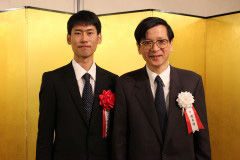
There were 98 applicants for the Student of the Year award nationwide.
On March 11, 2011, Yasuhara was working part-time at a canning factory in Yamagata Prefecture in order to save money for his tuition. After graduating from high school, he studied for one year and then passed the Chuo University entrance examination.
“The earthquake hit while I was taking a break. I saw the devastating scene on my cell phone and it left me speechless.”
The factory operations were suspended, and Yasuhara headed for Sendai Station on the factory bus.
“The entire street was completely dark. I was dropped off near Sendai Station, and walked all the way to my house. Sendai station was completely closed like all the train stations in Tokyo. The transportation systems were paralyzed. It took about three hours to return home, since our house was located 10 km away from the station.”
When he got home, his family was safe. The house had not collapsed but was flooded so they could not stay there. Together with his family, Yasuhara went to his uncle’s house in nearby Tagajo city where they stayed for one month. During this time, Yasuhara took pictures on his cell phone every day.
“It was like a movie scene. The street was not what I knew, and I was too shocked to shed tears. I worried about our future, but I knew that we had to get through it.”
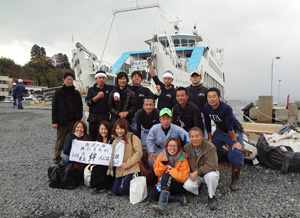
Yasuhara borrowed tents from a community center and used them as a roof for the long queue of victims in front of a water station. “At first, I didn’t know what to do at all.” Receiving information on disaster-relief volunteering, Yasuhara went to Matsushima, a famous sightseeing spot with his friends, uncle, and aunt to remove mud. After a volunteer center was established in Sendai, Yasuhara helped remove rubble for several days.
His grandparents, who had initially offered to pay part of his tuition, were also victims of the earthquake. The tuition fee was allocated to various repairs instead.
“I lost hope to go to university.”
Yasuhara called Chuo University without much hope. When he explained his situation, the administration office encouraged him, “Don’t worry about money. Please come to Tokyo. We will help.”
“I saw the light at the end of the tunnel.”
Receiving support from many people, Yasuhara finally arrived at the Tama Campus. There he received financial aid from the university, and local residents welcomed and assisted him at his new residence. The university staff also helped Yasuhara move his furniture by car.
Joining a volunteer club
“My dream of going to university came true, and I knew that my mission was to study. The people in the evacuation centers at the earthquake disaster site encouraged me to enter university.”
Yasuhara had already decided to join the International Volunteer Club Hitsuji-gumo, ever before university classes began.
Greatly concerned about the Tohoku region, Yasuhara went to Ishinomaki city and Higashi Matsushima city during the holidays in May. In June, Yasuhara revisited Higashi Matsushima city to remove the remaining mud.
After hearing that he could set up a tent for his activities at the volunteer center in Kesennuma city, Yasuhara got on his motorbike the morning after the semester exams, riding for 10 hours to get to Kesennuma.
Yasuhara packed his luggage onto his small 125cc motor scooter. He had already sold his favorite 400cc motorbike to help pay his university entrance fees.

At the end of July, Yasuhara set up a tent and started his volunteer activities in the city. In early August, other students from Chuo University headed for Oshima to participate in volunteer activities during their summer vacation. Yasuhara decided to join them in Kesennuma and traveled together, riding in his scooter behind their bus. Needless to say, the passengers of the bus were surprised to hear about his background.
When the student volunteers finished their activities, Yasuhara decided to stay in Kesennuma. He continued to camp in the tent. Yasuhara stayed in the city for 2 weeks, and then returned to Sendai during the Bon holidays. After the holidays, he went to Oshima again, and stayed there for 10 days.
“I got to meet many people staying for a long time.”
At Oshima, many of the residents were victims of the earthquake. Local people worked silently while they thought of their island and other victims. Their family members were missing and they had lost their fishing jobs.
The local workers were coined the “unselfish bunch,” for their unlimited generosity and kind actions.
The removal of rubble on the island was more difficult than that in Kesennuma. They had to sort the rubble into glass, lumber, and home appliances before they could remove it from the island.
Yasuhara felt resonance with the unselfish bunch, who were quiet and yet dedicated. They had the same compassion for their hometown as Yasuhara had for Sendai.
The unselfish bunch, who played a big role in supporting the island, sometimes showed their weakness. Yasuhara wondered how he could help those who seemed on the verge of losing their sanity.
Studying hard
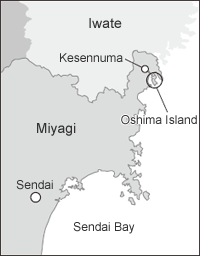
“I come from a low-ranking high school in Sendai. I had not even heard of Chuo University.”
Yasuhara loved motorcycles, and worked hourly jobs to purchase one. His school promoted volunteer activities, and gave extra credit to students who engaged in volunteer activities for a specified period of time.
“During my high school years, all I did was weed the schoolyard and visit welfare facilities. I joined the student council just to gain more credits. I studied only just before exams.”
For economic reasons, Yasuhara decided to take the entrance exams of national or public universities.
Yasuhara dreamed of becoming like his grandfather who worked as a teacher. He took exams at several universities including Fukushima University, but the results were disappointing. Yasuhara convinced his father to let him go to a cram school. At cram school, Yasuhara reflected on his dream.
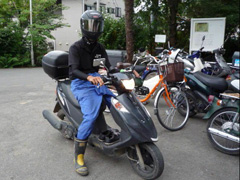
“If I become a teacher, will I be able to educate high school students like me? Do I like children? Many doubts emerged about pursuing a career as a teacher, and I concluded that I would do better supporting volunteer activities. I want to help people.”
Yasuhara did not pass the entrance exams because he did not study hard enough in high school.
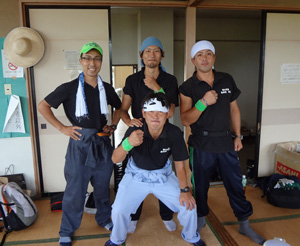
“When I joined cram school, I studied 13 to 14 hours a day. The cram school opened at 8:00 am and closed at 8:00 pm. After that, I studied English for one hour at home. I took only one day off, which I spent with my friends.”
Yasuhara went back to the basics. His scores rose in English and Mathematics, which were not his strong subjects. His academic performance improved considerably, and Yasuhara was able to aim for Meiji, Aoyama Gakuin, Rikkyo, Chuo, and Hosei Universities, collectively known as the MARCH group. The cram school held a briefing session on admission to Chuo University, and Yasuhara participated.
Yasuhara learned about the FLP, which is a cross-departmental program, and became interested in international cooperation. His aim was to enroll in the Faculty of Policy Studies in order to be able to judge things from a comprehensive viewpoint.
“In the beginning, entering a private university was not an option. After my persistent persuasion, however, my father finally gave me the opportunity to take one private university exam. Entering the Chuo University Faculty of Policy Studies turned out to be the perfect choice.”
What I started alone
There was a student who had wanted to volunteer in Tohoku before summer in the 1st year, who ended up not being able to go. The residents of Oshima in Miyagi Prefecture had hoped that students would visit them, as they were energized by the students who talked to them about their dreams.
Yasuhara came up with the idea of visiting Oshima with other students to participate in volunteer activities. The first crew planned to make the trip in late October. They decided that the number of participants would be five or six, depending on the accommodation facilities.
Yasuhara obtained a driver’s license. Until then, he had traveled mainly on his motorcycle, but that became impossible with several people.
He rented a car. The volunteer staff was scheduled to stay overnight on weekends during the semester, and for three or four days during vacations. The participation fee was set at 3,000 yen per person.
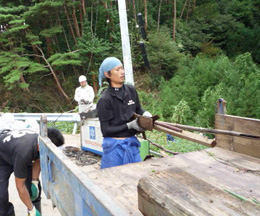
At the site, they removed rubble and helped the residents of the island cultivate oysters and scallops, providing help as needed. They assisted with children’s education in the summer of 2012, and helped the residents grow the local specialty flower camellia in 2013.
“The residents of Oshima are generous. When the students were leaving the island, they came to the ferry port to see us off. I saw the students changing in just a few days.”
The number of student volunteers fell in the autumn and the winter. Yasuhara was concerned that they would have to stop their volunteer activities, but he was saved when a participant introduced some potential volunteers to him.
Around the time of the Hakumon Festival, he purchased a used 7-seater minivan. By December, the volunteer crew was dispatched four times, leading to a deficit of 200,000 yen from rental car, expressway, and gasoline fees. For the fourth trip, a total of 12 students participated and they used the minivan plus a rental car.
“I didn’t think I should charge students excessive fees, but we spent 250,000 yen for transportation, while the revenue was 50,000 yen in total.”
He recognized the limitations of what he could do by himself, including the financial burden. He produced 300 flyers to invite participants, and distributed them around the Faculty of Policy Studies campus. He held briefings for participants, updated his website with the latest information, and wrote on his blog and Twitter.
Yasuhara was stubble-faced as he pushed on alone. He was nicknamed Jigen because he was similar to Daisuke Jigen, a character in the Japanese manga Lupin the Third and characterized by his beard. His group was named Team Jigen. Participants were not limited to the students of Chuo University, but included students of Soka, Waseda, Tokyo Keizai Universities, and Kanda University of International Studies, among others.
Over 100 students participated on weekends or during their spring or summer vacation. The bond between Oshima and the students was strengthened and their activities were highly evaluated. They then received support from Dentsu Ikueikai and Sumitomo Corporation, among other organizations.
“I was not good at working cooperatively in a group, and I tended to work alone. However, interacting with the residents of Oshima, I was moved by their personalities, and also by the beautiful landscape of their home. Then I started to hope I could bring students there to volunteer.”
Although he wants to return to Oshima in Miyagi Prefecture, Yasuhara also has his eye on northern Thailand in Southeast Asia. He plans to volunteer in a non-governmental organization (NGO) for protecting poor children from human trafficking.
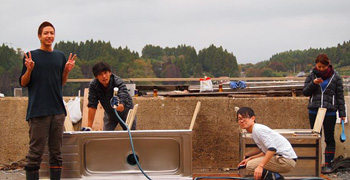
Devastated area tour (October 2012)
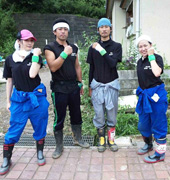
Volunteering members and the Unselfish Bunch (August 2011)
- Research Activities as a Member of Research Fellowship for Young Scientists (DC1), Japan Society for the Promotion of Science (JSPS) Shuma Tsurumi
- Important Factors for Innovation in Payment Services Nobuhiko Sugiura
- Beyond the Concepts of Fellow Citizens and Foreigners— To Achieve SDGs Goal 10 “Reduce Inequality Within and Among Countries” Rika Lee
- Diary of Struggles in Cambodia Fumie Fukuoka
- How Can We Measure Learning Ability?
—Analysis of a Competency Self-Assessment Questionnaire— Yu Saito / Yoko Neha - The Making of the Movie Kirakira Megane








